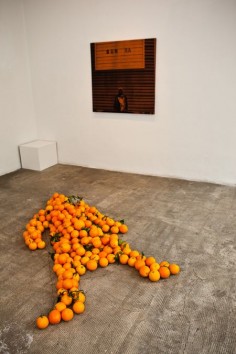ETTORE FAVINI
source: cargocollective
Born 1974, in Cremora, Italy, where he currently lives and works, Favini received a BFA in painting at the Academy of fine Arts of Brera, Milan. His work has been featured in international solo and group exhibitions, and published in various periodicals such as Flash Art, Cura and Arte e Critica. In 2010, Favini won the Moroso Award for contemporary Art, GC.AC Editions, Monfalcone.
.
.
.
.
.
.
source: marselleriaorg
“In the fog, the sun becomes white, it looks like a hole in the gray sky.” Bruno Munari.
After the solo shows Ogni cosa a suo tempo, 2011, at the Basilica of Santa Maria Maggiore in Bergamo, and Walden Method, 2010, at MAR – Art Museum of Ravenna, Ettore Favini presents in Milan, at Marsèlleria, a new series of works.
An artist manipulator of ideas and objects, thoughts and spaces, Ettore Favini builds his work within an intimate relationship with history and its relevance. A reader and interpreter of the social context observed in its complexity through public art actions too, he creates works and installations of great poetic and symbolic value. His interventions are organic, in the sense that they do not remain unchangeable, but rather, transform over time and in the space in which they find themselves to react. Without any mechanical modification, Favini interrogates time, memory, and landscape.
The relationship between time, public space, and nature is in fact among the recurrent themes in his artistic practice, and obsession for time is a constant. At the source of his new series of works, on display at Marsèlleria, there are: giving exposure to an invisible phenomenon, attempting to give shape to time, to narrate it, through a process that has lasted a year. A year dedicated to observing the guiding star: the Sun. Observing the solar analemma (the technical term of the Sun’s movement across the sky) brings back a shape that is similar to an 8, the lemniscate of mathematics, the symbol of infinity.
For some years now, the artist has been using processes that lead to an extended incubation, in order to better “digest” the process of making: for this series, Favini aimed some cameras on the Sun with a special sun filter and took a picture at the same time (12:15) according to an established calendar, always with the same frame, with the risk that all this waiting could be in vain due to a ray of light that could filter in and burn the frames. The result is an 8 suspended in a black sky, the form of infinity in the void, a shape that has perpetuated for years now and will continue to perpetuate, marking our time with the calendar.
Opening the show SunRa there is a work on canvas and an action dedicated to Io che prendo il sole a Torino il 19 gennaio 1969, work by Alighiero Boetti. Visitors will then enter a flow of forms and images, a process where the displayed elements have been directly transformed by the sun or refer to processes tied to the natural element. An investigation aimed at the multiple aspects this may assume, also in relation to history. This multiplicity is also present on a linguistic level: sculpture, collage, installation, are all media used by the artist in constant dialogue with each other.
.
.
.
.
.
.
.
.
source: artribune
Ci voleva uno tosto come Copernico per farci capire una volta per tutte che la Terra non è al centro dell’universo e anzi ricopre un ruolo secondario in un sistema detto “solare”, tanto per far capire che il vero protagonista di tutto questo teatro di stelle è in realtà un altro. Lo sa bene un artista come Ettore Favini (Cremona, 1974) le cui ultime opere dimostrano una forte attrazione – non solo gravitazionale – per il Sole: mischiando suggestioni astrologiche, pensieri filosofici e preoccupazioni ambientaliste (e riferimenti a Boetti e alla musica più visionaria), crea un racconto riuscitissimo e struggente intorno alla sua magnifica ma spesso terribile potenza, sospesa fra moti apparenti, vite da crescere e vite da bruciare. E gli spazi della Marsélleria offrono il palcoscenico ideale per inscenare i giri infiniti del nostro pianeta intorno alla propria luce, assecondando quella maledetta regola dell’amore per cui più ci avviciniamo a ciò di cui abbiamo bisogno, più veniamo respinti.


